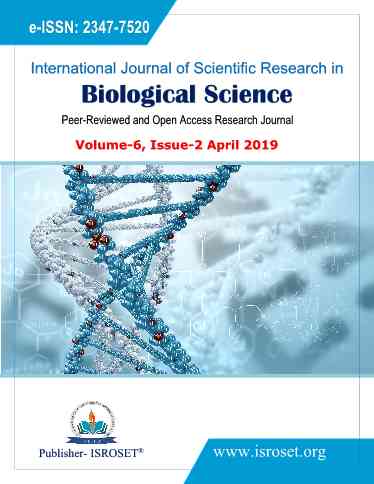In-vitro ACE inhibitor, Anti-inflammatory and Cytotoxicity study of Salvia (Chia) and Ocimum (Basil) Seeds
Keywords:
Antihypertension, Anti-inflammation, Cytotoxicity, Human Red Blood Cell MembraneAbstract
Chia seeds from Salvia hispanica and Basil seeds from Ocimum basilicum are increasingly being categorized as a novel food and have received scientific attention due to presence of high amounts of nutraceutical compounds. Recent studies demonstrate that both seeds are used as a medicine for the treatment of various kinds of diseases. Present study aims to determine their antihypertensive potential, anti-inflammatory action, and cytotoxicity. Hypertension is a major risk factor and Angiotensin Converting Enzyme (ACE) is one of the major regulators of blood pressure. Inflammation is response of body to an injury or infection. Drugs which are used as ACE inhibitors and anti-inflammatory possess undesirable side effects, while natural inhibitors have no side effects and are potential nutraceutical. In vitro assays were used to determine ACE inhibition and anti-inflammatory activity. The cytotoxicity assay for crude extract of defatted chia and basil seeds was done on human histiocytic lymphoma cell line (U937) by MTS assay. ACE inhibition activity assay showed that ethanolic and hexane extracts of both seeds have distinct ACE inhibitory activity. Both seed extracts had shown higher activity at 150 and 50 µg/mL concentrations respectively. Results of anti-inflammatory assay showed maximum protection of HBRC (Human Red Blood Cell Membrane Stabilization Method) at 50 and 75 µg/mL concentrations for both seeds in ethanolic and methanolic extracts. MTS assay showed 73.20% and 70.85% cytotoxicity of Chia and Basil seeds at 12.50 and 50µg/mL concentrations respectively. IC50 values of Chia and Basil seeds were found to be 14.09µg/mL and 23.46µg/mL. This study provides direction for future investigation concerning detailed assessment of therapeutic potential of Chia and Basil seeds.
References
N. Mohd Ali, S. Yeap, H. Wan Yong, B. Kee Beh, "The Promising Future of Chia, Salvia hispanica L", Journal of Biomedicine and Biotechnology, Hindawi Publishing Corporation, pp. 1-10, 2012.
K. Pant, K. Agarwal, P. Saini, "To study in vitro anti-inflammatory activity of Anthracephalus cadamba leaves extract", DHR International Journal of Pharmaceutical Sciences, Vol. 3, No. 1, pp. 55-60, 2012.
S. Suri, S. Jain Passi, J. Goyat, "Chia seed (Salvia Hispanica L.) – A new age functional food" [Conference]. New Delhi, pp. 752-765, 2016.
M. Shamloo, P. Eck, T. Beta, "Angiotensin converting enzyme inhibitory peptides derived from cereals", Journal of Human Nutrition & Food Science, Vol. 3, No. 1, pp. 1-10, 2015.
D. Prabhakaran, and P. Jeemon, "Cardiovascular diseases in India: Current epidemiology and future directions", [Online] http://circ.ahajournals.org, 2016.
P. Arora, and A. Chauhan, "Ace Inhibitors: A Comprehensive Review", International Journal of Pharmaceutical Science and Research, Vol. 4, No. 2, pp. 532-548, 2013.
D. Orona-Tamayo, M. Valverde, B. NietoRendon, O. Paredes-Lopez, "Inhibitory Activity of Chia (Salvia hispanica L.) Protein Fractions Against Angiotensin Iconverting enzyme and Antioxidant Capacity". Food Science and technology, pp. 236-242, 2015.
K. Kacmarova, B. Lavova, P. Socha, D. Urminska, "Characterization of protein fractions and antioxidant activity of Chia Seeds (Salvia Hispanica L.)". Potravinarstvo® Scientific Journal for Food Industry, Vol. 10, No. 1, pp. 78-82, 2016.
V. Godhandaraman, and S. Ramalingam, "In vitro anti-inflammatory activity of different parts of Pedalium murex (L.)", International Journal of Herbal Medicine, Vol. 4, pp. 31-36, 2016.
C. Anosike, O. Obidoa, L. Ezenyika, "Membrane stabilization as a mechanism of the anti-inflammatory activity of methanol extract of garden egg (Solanum aethiopicum)", DARU Journal of Pharmaceutical Science, Vol. 20, No. 76, pp. 1-7, 2012.
G. Dugganaboyana, C. Palanisamy, K. Kumar, S. Muthusami, K. Velliyur, "Dietary Evaluation, Antioxidant and Cytotoxic Activity of Crude Extract from Chia Seeds (Salvia hispanica L.) against Human Prostate Cancer Cell Line (PC-3)", International Journal of Pharmacognosy and Phytochemical Research, Vol. 8, No. 8, pp. 1358-1362, 2016.
S. Ingole, A. Kakde, P. Bonde, "A Review on Statistics of Cancer in India". IOSR Journal of Environmental Science, Toxicology and Food Technology, : Vol. 10, No. 7, pp. 107-116, 2016.
M. Belovic, N. Ilic, A. Tepic, Z. Sumic, "Selection of conditions for angiotensin– converting enzyme inhibition assay: influence of sample preparation and buffer", Food and Feed Research, Vol. 40, No. 1, pp. 11-15, 2013.
N. Kumar, A. Singh, D. Sharma, K. Kishore, "In-vitro anti-inflammatory and antioxidant activity of Onosma hispidum (Ratanjot) roots", International Journal of Pharmacy and Biological Sciences, Vol. 7, No. 3, pp. 30-35, 2017.
M. Musfiq, and T. Ananthi, "In vitro antiinflammatory activity of seed extract of Zea mays (L.)", Journal of Global Bioscience", Vol. 4, No. 5, pp. 2168-2173, 2015.
EZcountTM MTS Cell Assay Kit (Product Code: CCK053) .
U. Muthuswamy, A. Mathew Puthenpurackal, A. Kuppusamy, S. Thirumalaiswamy, S. Varadharajan, J. Puliyath, "In vitro angiotensin converting enzyme inhibitory and antioxidant activities of seed extract of Apium graveolens Linn", Annals of Biological Research, Vol. 3, No. 3, pp. 1274-1282, 2012.
A. Gajendiran, V. Thangaraman, S. Thangamani, D. Ravi, J. Abraham, "Antimicrobial, antioxidant and anticancer screening of Ocimum basilicum seeds", Bulletin of Pharmaceutical Research, Vol. 6, No. 3, pp. 114-119, 2016.
F. Hashim, M. Shawkat, H. Al-Jewari, "Cytotoxicity of curcumin against Leukemic Cell Lines via apoptosis activity", Current Research Journal of Biological Sciences, Vol. 4, No. 1, 60-64, 2012.
Downloads
Published
How to Cite
Issue
Section
License

This work is licensed under a Creative Commons Attribution 4.0 International License.
Authors contributing to this journal agree to publish their articles under the Creative Commons Attribution 4.0 International License, allowing third parties to share their work (copy, distribute, transmit) and to adapt it, under the condition that the authors are given credit and that in the event of reuse or distribution, the terms of this license are made clear.







